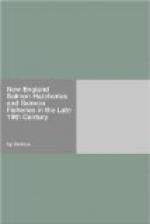As remarked above, only flesh-eating maggots have yet been tried. It would be well worth while to experiment with the larvae of other species, such as the house fly, the stable fly, etc. There is also a white maggot known to grow in heaps of seaweed. Should the rate of growth of either of these species be found to be satisfactory they might be substituted for the flesh maggots with advantage.
Occasional use has been made of fresh fish for direct feeding. When thrown into the water after chopping it breaks up into fibers to such an extent that it is not very satisfactory, and I do not suppose we shall use it in the future, unless in a coarsely chopped form for the food of large fish. A few barrels of salted alewives have been used, and if well soaked out and chopped they are readily eaten by the larger fish and can be fed to fry, but are less satisfactory with the latter, and like fresh fish they break up to such an extent that they are only to be regarded as one of the last resorts.
Fresh-water mussels have been occasionally gathered in the lake close to the station when there has been a scarcity of food. Those employed belong almost wholly to a species of Unio which abounds over a considerable area of soft bottom, under a depth of 2 to 10 feet of water. Many were taken with a boat dredge; more were scooped up with long-handled dip nets of special construction. Finally a wide, flat dredge was made, to be drawn by a windlass on the shore and manipulated by means of poles from a large boat.
When needed for food the mussels were opened with knives—a great task—and chopped. The meat is readily eaten by all fishes, and appears to form an excellent diet. Being more buoyant than any other article tried, it sinks slower in the water and gives the fish more time to seize it before it reaches the bottom, a consideration of considerable practical importance. The labor involved in dredging and shelling is a serious drawback, but were the colonies of unios sufficiently extensive or their reproduction rapid enough to warrant expenditure of time in experimentation; improved methods might be devised, which would put this food-source on a practicable basis.
During the seasons of 1886 and 1888 some use was made of mosquito larvae. Near the station is an extensive swamp where these insects breed in great numbers. From the pools of water the larvae were daily collected by means of a set of strainers specially devised for this use. Barrels filled with water were also disposed in convenient places near the rearing troughs, and were soon swarming with larvae from the eggs deposited by the mosquitoes on the surface of the water. When near the completion of their growth, which was only some ten days after the deposit of the eggs, the larvae (or pupae) were strained out and fed to the fish. No kind of food has been used this station that has been more eagerly devoured, and so far as our observation has gone no other food has contributed more to the growth of the fish; indeed, I am inclined to put them at the head in both respects. It was found, however, that the time expended in collecting them was out of all proportion to the quantity of food secured, and pending opportunity for further experiment their use was discontinued.




